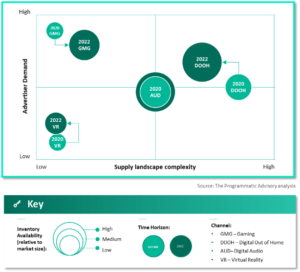Audio, DOOH, VR and Gaming: Education a Bigger Challenge than Infrastructure
by Mathew Broughton on 3rd Mar 2020 in News

In this exclusive article written for ExchangeWire, the team at The Programmatic Advisory discusses the opportunity in emerging channels, namely audio, gaming, DOOH, and VR, and the factors which are currently hindering their widespread adoption.
Programmatic has worked hard to shed its reputation as remnant inventory, earning itself a seat at the established media table. But now, it finds itself fighting an uphill battle against regulation, cookie depreciation and tracking restrictions. While change is on the horizon and many vendors look to offer future-proof solutions, could this finally be push we need to embrace other programmatic channels to the fullest?
We have long been captivated by the possibilities of accuracy and accountability of programmatic display, resulting in inadvertent scepticism towards other channels that cannot offer the same granularity we’re accustom to. Newly digitised programmatic channels, such as audio and digital out-of-home (DOOH) offer far more accuracy and accountability in comparison to their traditional counterparts, yet many advertisers are still looking to draw direct comparisons to display in terms of measurement and functionality. New programmatic channels such as gaming and VR are also hindered by these comparisons, despite not having had enough time to have made all the necessary integrations and partnerships yet.
Gaming, Audio, DOOH and VR have each already demonstrated impressive growth, holding ample opportunity for investment:
- DOOH is now over half of OOH spend in the UK at £516m.
- Audio advertising is on track to become a £1.25bn market.
- Gaming is becoming mainstream; US ad revenue is on track for USD$3.67bn (£2.84bn) in 2020.
- The VR industry is expected to be worth more than USD$43bn (£33.3bn) by 2023.
These mediums are more important than ever given they are less reliant on the audience data that has traditionally been used in programmatic. Programmatic DOOH and audio provide scope for improved efficiency and creativity in quality environment. Gaming and VR’s biggest opportunities centre around their captive, otherwise difficult to reach, audience demographic.

Despite the opportunities at hand, the fragmentation and complexity of the landscape can drive markerters’ hesitancy for investment:
- DOOH currently suffers considerable fragmentation, which can make purchasing overwhelming. Though with Global’s entry into DOOH we expect this to improve and for demand to increase as a result.
- Audio is one of the more established channels boasting a more mature infrastructure. There has already been significant growth in this area, and we expect the growth here to reflect broader media trends.
- Gaming is generating considerable demand, though the infrastructure and inventory aren’t fully there yet. As supply begins to match demand, we expect enhanced inventory volumes but greater fragmentation due to new entrants.
- VR is currently hindered by consumer uptake, meaning demand and supply are limited. Until this becomes a standard media format, we expect limited growth in the short term.
These varying levels of maturity, combined with inconsistent measurement frameworks, can be difficult to navigate when it comes to planning and activation. Education will therefore be a critical enabler of increased uptake of these emerging channels. Ongoing education efforts are required to help agencies, publishers and advertisers determine where ownership of these channels is best suited (traditional OOH/AV teams or programmatic). And with ownership established, agencies and advertisers can understand the true potential that application holds for their audiences and successfully communicate this value to their stakeholders internally and externally.
Demand will fuel development towards marketplaces that are easier to navigate, and education will push measurement progress and adoption of new ways to transact.
Find out more in our whitepaper, where we look to demystify the current state of availability and functionality per channel, helping to encourage relevant application and understanding.








Follow ExchangeWire